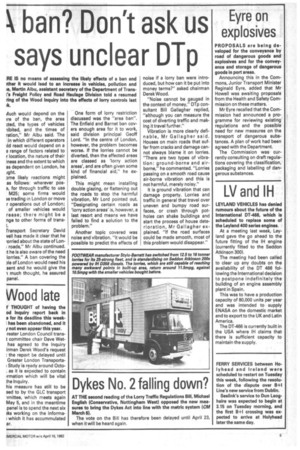k ban? Don't ask us says unclear DT
Page 5

If you've noticed an error in this article please click here to report it so we can fix it.
RE IS no means of assessing the likely effects of a ban and nher it would lead to an increase in vehicles, pollution and le, Martin Albu, assistant secretary of the Department of Transt's Freight Policy and Road Haulage Division told a resumed ring of the Wood Inquiry into the effects of lorry controls last ok.
Auch would depend on the ire of the ban, the area ted, the types of vehicles libited, and the times of ration," Mr Albu said. The in which different operators ild react would depend on a e range of factors related to r location, the nature of their iness and the extent to which as dependent on London, he aght.
Dme likely reactions might as follows: wherever pose, for through traffic to use M25; some firms would 3e trading in London or move r operations out of London; of smaller vehicles would rease; there might be a nge to other forms of trans
Transport Secretary David veil has made it clear that he 'orried about the state of Lonroads," Mr Albu continued.
he is also aware of the need lorries." A ban covering the )le of London would need his sent and he would give the .1 much thought, he assured panel.
One form of lorry restriction discussed was the "area ban". The Enfield and Barnet ban covers enough area for it to work, said division principal Geoff Lord, "In the centre of London, however, the problem becomes worse. If the lorries cannot be diverted, then the affected areas are classed as 'lorry action areas', and are often given some kind of financial aid," he explained.
This might mean installing double glazing, or flattening out the roads to stop the harmful vibration, Mr Lord pointed out. "Designating certain roads as 'lorry action areas' is, however, a last resort and means we have failed to find a solution to the problem."
Another topic covered was noise and vibration. "It would be possible to predict the effects of noise if a lorry ban were introduced, but how can it be put into money terms?" asked chairman Derek Wood.
"Noise cannot be gauged in the context of money," DTp consultant Bill Gallagher replied, "although you can measure the cost of diverting traffic and making it travel further."
Vibration is more clearly definable, Mr Gallagher said. Houses on main roads that suffer from cracks and damage cannot always blame it on lorries. "There are two types of vibration: ground-borne and airborne," he commented. "Lorries passing on a smooth road cause air-borne vibration and this is not harmful, merely noisy."
It is ground vibration that can damage property. Lorries and traffic in general that travel over uneven and bumpy road surfaces, or crash through potholes can shake buildings and start the process of house deterioration, Mr Gallagher explained. "If the road surfaces could be made smooth, most of this problem would disappear."




















































